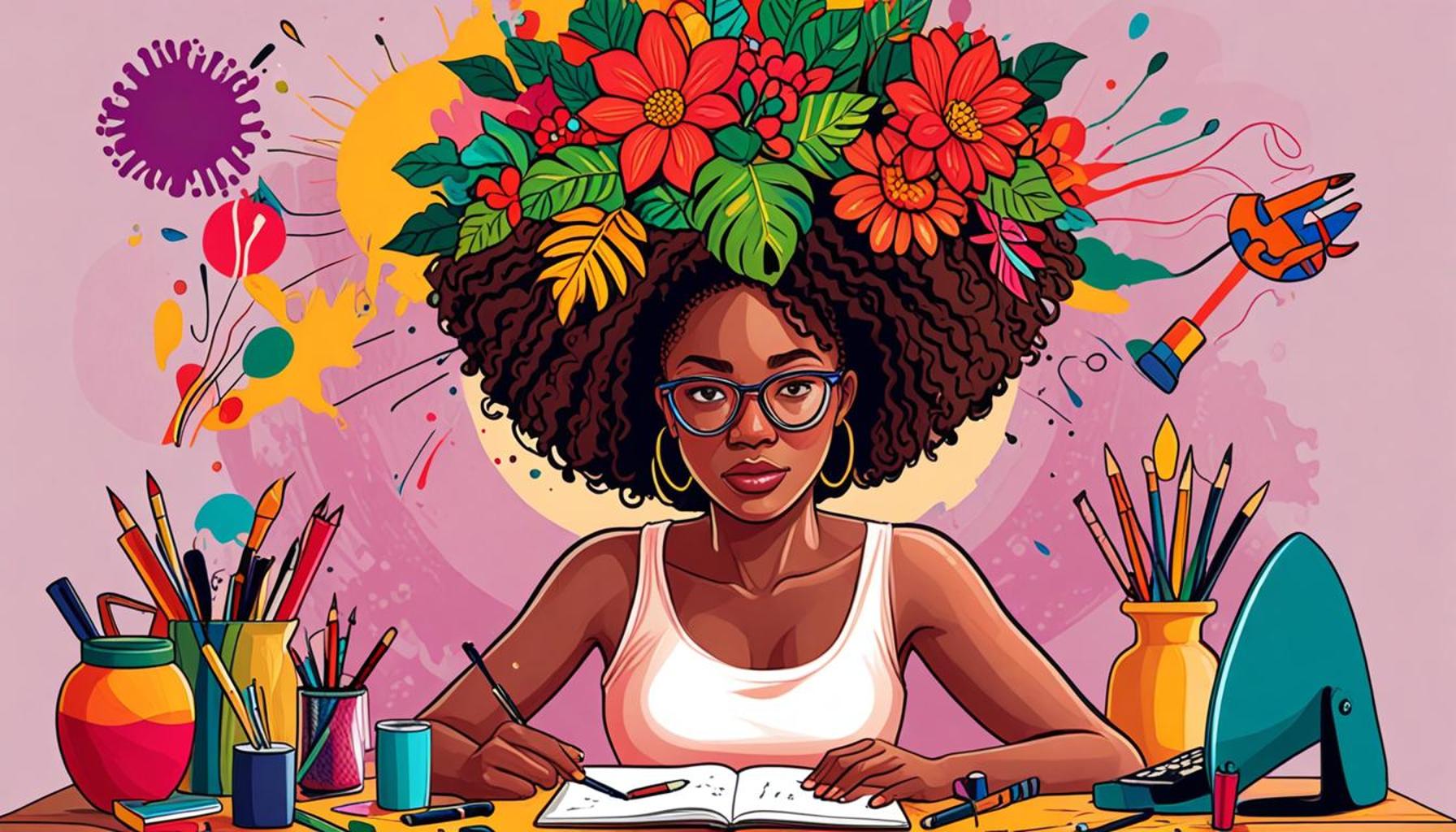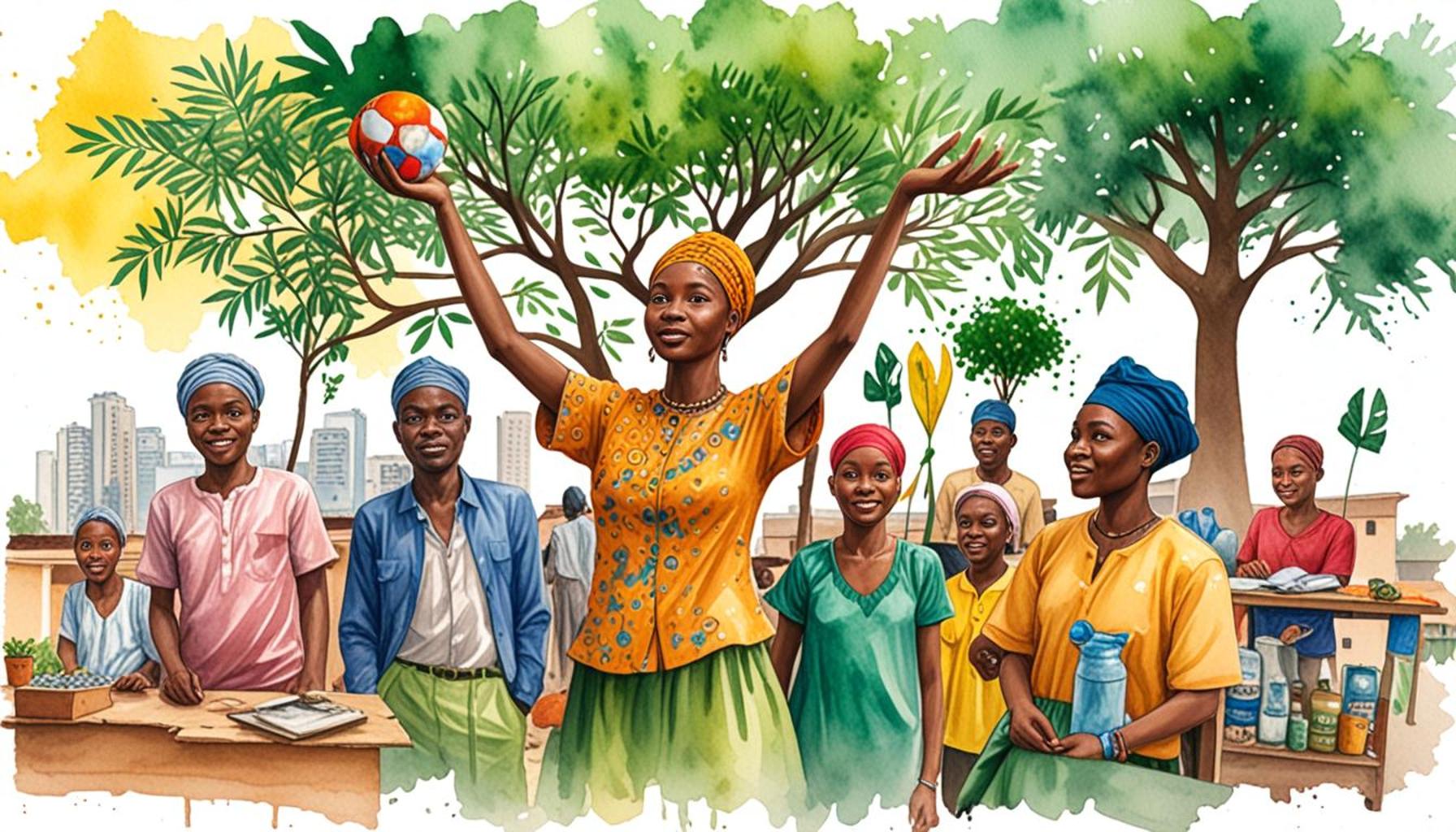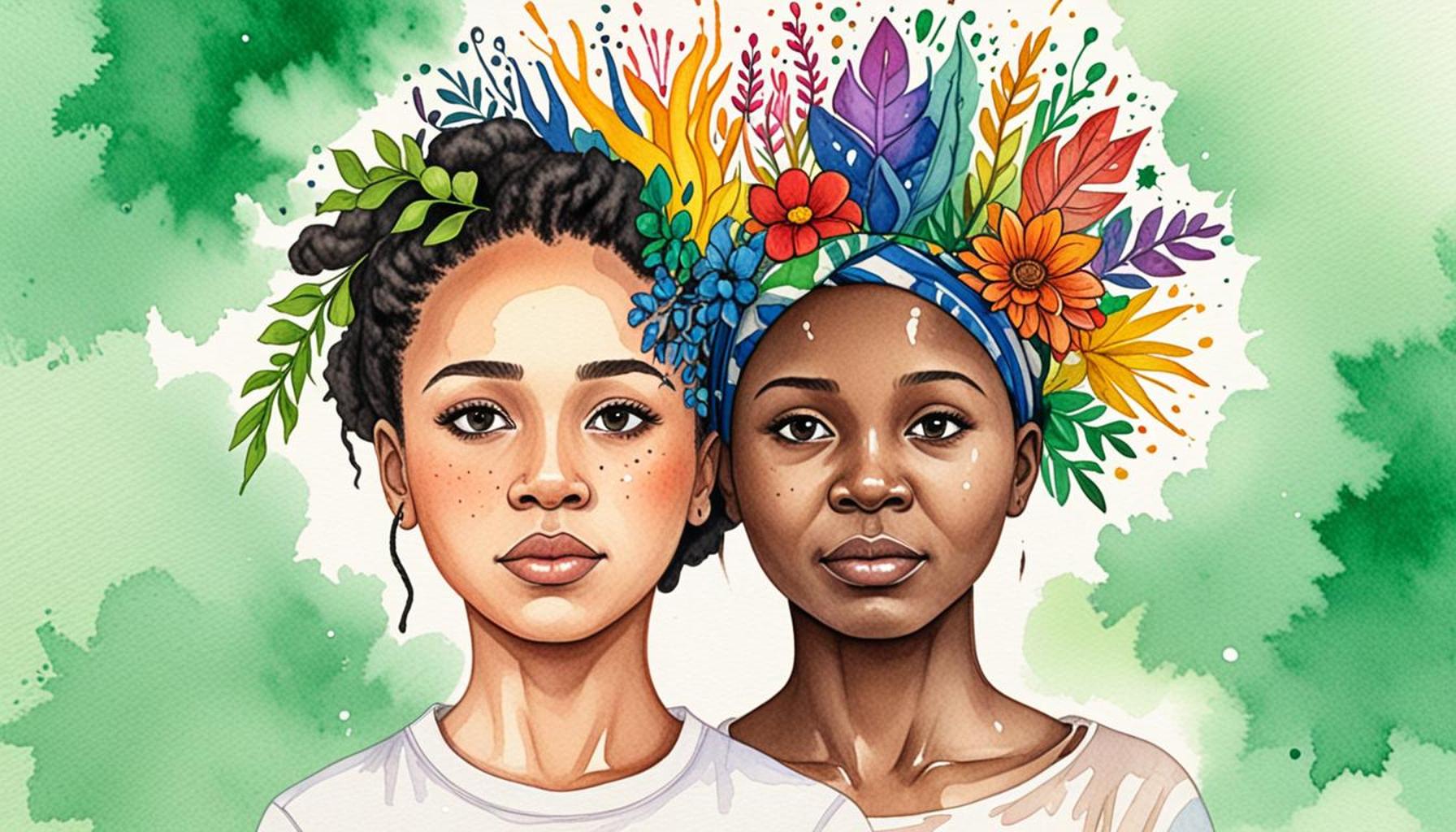Resilience in the Creative Sector: The Importance of a Growth Mindset for Nigerian Artists and Designers

The Role of Resilience in Nigerian Creativity
Nigerian artists and designers often operate in a landscape marked by unique challenges, including economic fluctuations, infrastructural deficiencies, and a complex cultural tapestry. However, in this dynamic environment, one trait stands out as a fundamental pillar—resilience. This quality enables creatives to withstand pressures and emerge stronger, crafting works that resonate not only within Nigeria but also on global stages.
The idea of a growth mindset is pivotal in nurturing such resilience. A growth mindset empowers individuals to perceive challenges as stepping stones to success rather than formidable barriers. For Nigerian artists and designers, this mental framework can catalyze profound transformations in their careers and artistic expression.
Innovation through Challenge
Embracing obstacles can ignite an innovative spirit. For instance, a painter may encounter limited access to traditional materials, prompting them to explore and experiment with recycled or unconventional resources, thus creating art that speaks to environmental concerns. This shift not only fosters creativity but also positions the artist as a pioneer in their field. An example is renowned Nigerian artist El Anatsui, who transforms discarded materials into stunning installations, highlighting the beauty of reclamation while addressing broader themes of waste and sustainability.
Adaptability in Artistic Practice
A growth mindset also cultivates adaptability. Nigerian creatives often face changing market demands, socio-political shifts, or even technological advancements. Instead of resisting these changes, artists can adjust their techniques or themes to stay relevant. For example, graphic designers in Nigeria increasingly utilize digital platforms for their work, capitalizing on social media and online marketplaces to reach wider audiences. The ability to pivot can lead to greater visibility and success in an often unpredictable industry.
Collaboration as a Catalyst for Growth
Moreover, resilience fosters a spirit of collaboration. Artists who embrace this mindset are typically more open to forming partnerships that enhance their craft. Collaborative projects can lead to the blending of diverse skills, resulting in innovative works that reflect a multitude of perspectives. An excellent illustration of this is the collaborative efforts seen in Nigeria’s Nollywood film industry, where writers, producers, and directors often join forces to create stories that resonate with local and international viewers.

As we examine the intersection of resilience and a growth mindset, it becomes evident that these elements are crucial for the evolution of Nigeria’s creative industry. Strengthening this relationship can empower individual artists while simultaneously fortifying the creative community as a whole. The rich tapestry of Nigerian art and design has the potential to flourish, driven by artists who leverage resilience to navigate challenges and create impactful works.
Ultimately, by nurturing resilience through a growth mindset, Nigerian creatives not only enhance their personal journeys but also contribute woven narratives that enrich the country’s cultural fabric. As they continue to explore and innovate, these artists stand as testaments to the power of perseverance and creativity in shaping the future.
SEE ALSO: Click here to read another article
Cultivating a Resilient Mindset: Strategies for Success
For Nigerian artists and designers, fostering a resilient mindset is not merely about enduring hardship; it requires active engagement with the challenges faced within the creative landscape. To achieve long-term success, these creatives must employ various strategies that contribute to a robust and adaptable outlook. Here are some key approaches to cultivating resilience through a growth mindset:
- Continuous Learning: Embracing education is essential for Nigerian artists and designers. By seeking knowledge through workshops, online courses, or mentorships, creatives can acquire new skills and insights that enhance their artistic practice. This pursuit of learning encourages them to experiment with different styles and techniques, ultimately strengthening their versatility.
- Network Building: Creating a strong network enables artists to connect with other professionals in their field. Collaborating with peers allows for the exchange of ideas and resources, leading to innovative projects. Engaging with fellow creatives can also provide emotional support, reinforcing resilience while navigating the often-turbulent waters of the creative sector.
- Mindfulness Practices: Engaging in practices such as meditation or journaling can help artists manage stress and focus on their creative processes. Mindfulness encourages individuals to remain present and embrace the journey of their artistic endeavors, enabling them to see obstacles as opportunities for growth rather than as impediments.
- Setting Realistic Goals: Establishing achievable targets helps Nigerian creatives maintain motivation and track their progress. By breaking down larger ambitions into manageable milestones, artists can celebrate small victories, and this incremental approach can reinforce their commitment to resilience.
- Seeking Feedback: Actively seeking constructive criticism from peers or mentors can provide valuable insights into one’s work. This openness to feedback fosters a growth mindset, allowing artists to view criticism as a tool for improvement rather than a setback.
In Nigeria’s vibrant hinterland of creativity, where shifts in societal perspectives are constantly evolving, adopting these strategies can significantly impact an artist’s or designer’s resilience. Continuous learning and the willingness to adapt are key components in a rapidly changing industry, where public taste and technology can shift overnight.
The Power of Self-Reflection
Additionally, self-reflection plays a crucial role in reinforcing resilience. Taking time to evaluate past experiences—both successes and failures—enables Nigerian creatives to identify patterns, understand their responses to challenges, and make informed decisions for future endeavors. By embracing introspection, artists can develop a deeper awareness of their strengths and limitations, paving the way for transformative growth.
The intersection of resilience and a growth mindset extends beyond individual artists; it recognizes the collective strength of Nigeria’s creative community. When artists come together to share their journeys, they cultivate a culture of support and inspiration that uplifts everyone involved. Whether it is through art exhibitions, design fairs, or informal meetups, these interactions fortify the industry and contribute to a thriving creative ecosystem.
Ultimately, by prioritizing resilience through a growth mindset, Nigerian artists and designers can navigate their complex environment more effectively. As they embrace new challenges and foster a spirit of collaboration, their work not only evolves but also enriches the broader cultural narrative within Nigeria and beyond.
Embracing Challenges as Opportunities
In the creative sector, particularly for Nigerian artists and designers, adopting a growth mindset is critical in navigating challenges. Rather than viewing obstacles as failures, those with a growth mindset see them as stepping stones to greater creativity and innovation. This perspective encourages individuals to experiment, take risks, and ultimately, push the boundaries of their art. For instance, the recent challenges faced by the art community during the pandemic have led many artists to explore digital platforms and alternative forms of expression, showcasing the resilience inherent in their practices.
Networking and Collaboration
Another integral aspect of embracing a growth mindset is the willingness to collaborate and network. Nigerian artists and designers are increasingly recognizing the importance of creating connections within their community. By building partnerships and engaging in joint projects, artists can share resources, ideas, and strategies, further enhancing their craft. This collaborative spirit fosters a supportive environment that can propel both individual growth and the collective advancement of the creative sector.
Continued Learning and Adaptation
The creative landscape is continually evolving, necessitating a commitment to lifelong learning. A growth mindset inherently encourages artists and designers to seek out new skills and knowledge, ensuring they remain relevant in an ever-changing market. Online courses, workshops, and mentoring programs are increasingly accessible and can provide significant value for artists looking to enhance their toolkit. This dedication to personal development not only improves their own practice but also uplifts the entire creative community.
| Advantages | Description |
|---|---|
| Enhanced Creativity | Seeing challenges as opportunities helps artists to think outside the box. |
| Stronger Networks | Collaboration fosters community and shared resources, improving the overall quality of work. |
| Lifelong Learning | Commitment to learning ensures artists remain innovative and relevant in their techniques. |
The Impact of Mindset on Success
The way Nigerian artists and designers perceive their abilities significantly influences their success. A strong growth mindset allows them to embrace feedback as a crucial tool for improvement, rather than as a personal critique. This attitude empowers artists to persist in their endeavors, adapt to industry changes, and ultimately thrive. As the global marketplace for art expands, the resilience cultivated through a growth mindset will be invaluable in navigating this competitive terrain.
Conclusion: The Continuous Journey
In summary, fostering a growth mindset serves as an essential foundation for resilience in the creative sector of Nigeria. Artists and designers who dare to face challenges head-on, collaborate actively, and commit to ongoing learning are well-positioned to not only survive but flourish in the vibrant arts landscape. As the future unfolds, the emphasis on embracing a growth mentality will undoubtedly shape the trajectory of Nigerian creatives.
LEARN MORE: This related article may interest you
Embracing Innovation: The Role of Technology in Building Resilience
In today’s fast-paced creative industry, technological advancements play a pivotal role in shaping the landscape for Nigerian artists and designers. The integration of digital tools not only enhances the creative process but also fosters resilience by allowing artists to adapt quickly to market demands and trends. The adoption of technology is no longer a luxury; it is a necessity for survival and growth.
- Utilizing Social Media Platforms: Social media serves as a formidable tool for artists and designers to showcase their work, connect with audiences, and gain exposure. Platforms like Instagram, Facebook, and TikTok offer unique opportunities for creatives to build their personal brands while engaging directly with potential clients and fans. This presence can be instrumental in weathering financial uncertainties, as it provides a direct channel for promoting artworks or designs, securing commissions, and selling products.
- Exploring E-commerce: The rise of online marketplaces has revolutionized the way artists distribute their creations. Websites like Jumia, Etsy, and local platforms allow Nigerian creatives to reach a broader audience beyond geographical boundaries. This shift towards e-commerce not only enhances the visibility of their work but also establishes alternative revenue streams, fortifying their financial resilience in times of economic fluctuation.
- Embracing Collaborative Technologies: Tools that facilitate collaboration, like Slack, Zoom, and Google Workspace, enable artists to work together seamlessly, regardless of their location. These technologies support the pooling of ideas and resources, driving innovative projects while reinforcing a sense of community. By working collaboratively, Nigerian creatives can tackle challenges more effectively and share the burden of resilience.
Navigating Cultural and Economic Contexts
Resilience in the creative sector is also tied closely to an artist’s ability to navigate Nigeria’s unique cultural and economic contexts. Understanding and leveraging local narratives can provide a solid foundation for creative expression while addressing relevant social issues. By reflecting on the rich cultural heritage and contemporary experiences of Nigerian society, artists can create impactful works that resonate with their audiences. Such cultural relevance fosters emotional connections, often translating into greater support and appreciation from the community, which can spark further innovation and engagement.
Moreover, during economic downturns or periods of uncertainty, local storytelling can serve as a cushion against external pressures. For example, artists and designers who infuse elements of Nigerian folklore, art history, or societal narratives into their work not only celebrate their heritage but also create a solid market niche that appeals to both local and international audiences.
Navigating the complexities of the Nigerian market requires artists and designers to remain agile, continuously testing new ideas and approaches. The practice of seeking partnerships with businesses, fashion labels, or tech companies can lead to unique collaborations that not only expand an artist’s portfolio but also provide financial security during tough times.
In an age where change is the only constant, resilience stems from a commitment to continuous evolution. For Nigerian artists and designers, understanding the interplay between innovation, technology, and cultural context is integral to crafting a sustainable practice. By combining traditional skills with modern tools, they not only enhance their creative output but also build a resilient foundation that empowers them to thrive amidst challenges.
LEARN MORE: This related article may interest you
Conclusion: Cultivating a Resilient Future
In conclusion, resilience within the creative sector is not merely a response to challenges, but an evolving mindset that empowers Nigerian artists and designers to thrive in a complex and dynamic environment. By embracing a growth mindset, creatives can transform obstacles into opportunities, showcasing the deep cultural narratives and innovative expressions that define Nigeria’s rich artistic heritage. As the industry continues to evolve, the integration of technology—from digital art platforms to e-commerce solutions—becomes essential for survival and prosperity. Artists and designers who leverage these tools can elevate their visibility, secure new revenue streams, and foster collaboration, ultimately reinforcing their resilience.
Furthermore, navigating Nigeria’s unique economic landscape requires flexibility and adaptability. By intertwining local narratives with contemporary ideas, artists not only resonate more profoundly with audiences but also cement their place in the global creative economy. This approach not only enhances their brand identity but also cultivates community support, fueling further creativity and innovation.
As we look towards the future, it is imperative for Nigerian artists and designers to continue fostering their resilience through ongoing education, collaborations, and embracing technological advancements. By doing so, they not only ensure their artistic survival but also contribute to a vibrant, diverse, and impactful creative sector. In essence, the combination of resilience, innovation, and a growth mindset will pave the way for a thriving artistic community that mirrors Nigeria’s potential on the world stage.


